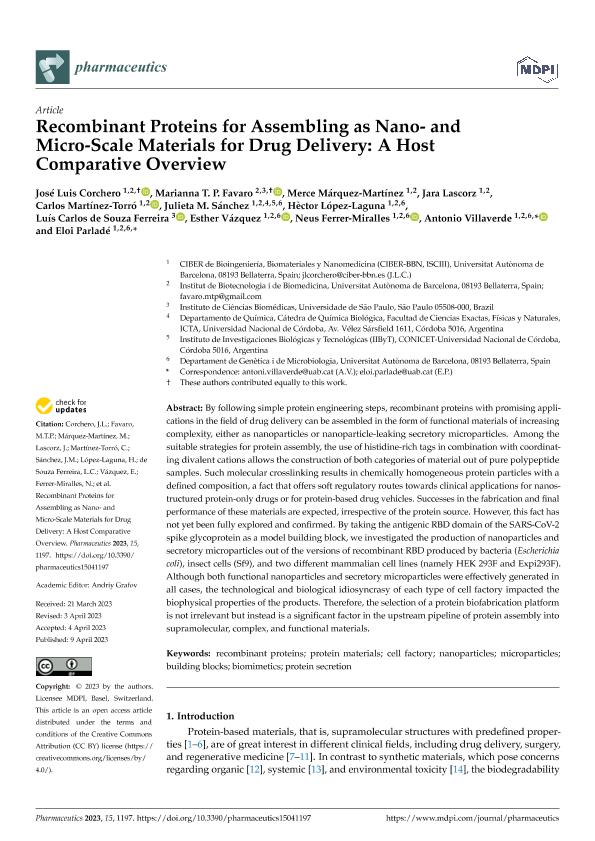Mostrar el registro sencillo del ítem
dc.contributor.author
Corchero, José Luis
dc.contributor.author
Favaro, Marianna T. P.
dc.contributor.author
Márquez Martínez, Merce
dc.contributor.author
Lascorz, Jara
dc.contributor.author
Martínez Torró, Carlos
dc.contributor.author
Sanchez, Julieta Maria

dc.contributor.author
López Laguna, Hèctor
dc.contributor.author
de Souza Ferreira, Luís Carlos
dc.contributor.author
Vázquez, Esther
dc.contributor.author
Ferrer Miralles, Neus
dc.contributor.author
Villaverde Corrales, Antonio

dc.contributor.author
Parladé, Eloi
dc.date.available
2024-03-19T16:32:19Z
dc.date.issued
2023-04-09
dc.identifier.citation
Corchero, José Luis; Favaro, Marianna T. P.; Márquez Martínez, Merce; Lascorz, Jara; Martínez Torró, Carlos; et al.; Recombinant Proteins for Assembling as Nano- and Micro-Scale Materials for Drug Delivery: A Host Comparative Overview; Multidisciplinary Digital Publishing Institute (MDPI); Pharmaceutics; 15; 4; 9-4-2023; 15041197: 1-16
dc.identifier.issn
1999-4923
dc.identifier.uri
http://hdl.handle.net/11336/230949
dc.description.abstract
By following simple protein engineering steps, recombinant proteins with promising applications in the field of drug delivery can be assembled in the form of functional materials of increasing complexity, either as nanoparticles or nanoparticle-leaking secretory microparticles. Among the suitable strategies for protein assembly, the use of histidine-rich tags in combination with coordinating divalent cations allows the construction of both categories of material out of pure polypeptide samples. Such molecular crosslinking results in chemically homogeneous protein particles with a defined composition, a fact that offers soft regulatory routes towards clinical applications for nanostructured protein-only drugs or for protein-based drug vehicles. Successes in the fabrication and final performance of these materials are expected, irrespective of the protein source. However, this fact has not yet been fully explored and confirmed. By taking the antigenic RBD domain of the SARS-CoV-2 spike glycoprotein as a model building block, we investigated the production of nanoparticles and secretory microparticles out of the versions of recombinant RBD produced by bacteria (Escherichia coli), insect cells (Sf9), and two different mammalian cell lines (namely HEK 293F and Expi293F). Although both functional nanoparticles and secretory microparticles were effectively generated in all cases, the technological and biological idiosyncrasy of each type of cell factory impacted the biophysical properties of the products. Therefore, the selection of a protein biofabrication platform is not irrelevant but instead is a significant factor in the upstream pipeline of protein assembly into supramolecular, complex, and functional materials.
dc.format
application/pdf
dc.language.iso
eng
dc.publisher
Multidisciplinary Digital Publishing Institute (MDPI)
dc.rights
info:eu-repo/semantics/openAccess
dc.rights.uri
https://creativecommons.org/licenses/by/2.5/ar/
dc.subject
BIOMIMETICS
dc.subject
BUILDING BLOCKS
dc.subject
CELL FACTORY
dc.subject
MICROPARTICLES
dc.subject
NANOPARTICLES
dc.subject
PROTEIN MATERIALS
dc.subject
PROTEIN SECRETION
dc.subject
RECOMBINANT PROTEINS
dc.subject.classification
Nano-materiales

dc.subject.classification
Nanotecnología

dc.subject.classification
INGENIERÍAS Y TECNOLOGÍAS

dc.title
Recombinant Proteins for Assembling as Nano- and Micro-Scale Materials for Drug Delivery: A Host Comparative Overview
dc.type
info:eu-repo/semantics/article
dc.type
info:ar-repo/semantics/artículo
dc.type
info:eu-repo/semantics/publishedVersion
dc.date.updated
2024-02-22T13:40:52Z
dc.journal.volume
15
dc.journal.number
4
dc.journal.pagination
15041197: 1-16
dc.journal.pais
Suiza

dc.description.fil
Fil: Corchero, José Luis. Universitat Autònoma de Barcelona; España
dc.description.fil
Fil: Favaro, Marianna T. P.. Universitat Autònoma de Barcelona; España. Universidade de Sao Paulo; Brasil
dc.description.fil
Fil: Márquez Martínez, Merce. Universitat Autònoma de Barcelona; España
dc.description.fil
Fil: Lascorz, Jara. Universitat Autònoma de Barcelona; España
dc.description.fil
Fil: Martínez Torró, Carlos. Universitat Autònoma de Barcelona; España
dc.description.fil
Fil: Sanchez, Julieta Maria. Universitat Autònoma de Barcelona; España. Consejo Nacional de Investigaciones Científicas y Técnicas. Centro Científico Tecnológico Conicet - Córdoba. Instituto de Investigaciones Biológicas y Tecnológicas. Universidad Nacional de Córdoba. Facultad de Ciencias Exactas, Físicas y Naturales. Instituto de Investigaciones Biológicas y Tecnológicas; Argentina
dc.description.fil
Fil: López Laguna, Hèctor. Universitat Autònoma de Barcelona; España
dc.description.fil
Fil: de Souza Ferreira, Luís Carlos. Universidade de Sao Paulo; Brasil
dc.description.fil
Fil: Vázquez, Esther. Universitat Autònoma de Barcelona; España
dc.description.fil
Fil: Ferrer Miralles, Neus. Universitat Autònoma de Barcelona; España
dc.description.fil
Fil: Villaverde Corrales, Antonio. Universitat Autònoma de Barcelona; España
dc.description.fil
Fil: Parladé, Eloi. Universitat Autònoma de Barcelona; España
dc.journal.title
Pharmaceutics
dc.relation.alternativeid
info:eu-repo/semantics/altIdentifier/doi/http://dx.doi.org/10.3390/pharmaceutics15041197
dc.relation.alternativeid
info:eu-repo/semantics/altIdentifier/url/https://www.mdpi.com/1999-4923/15/4/1197
Archivos asociados
